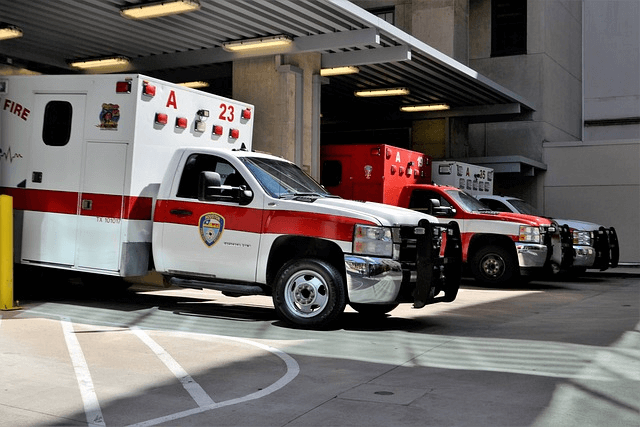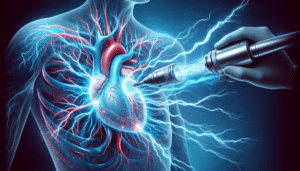In this article, let’s try to understand and manage a condition that affects millions worldwide – Atrial Fibrillation with Rapid Ventricular Response (also called AFib with RVR). This irregular heart rhythm is not just another medical term; it is a condition that could potentially impact you or someone you hold dear.
Let us embark on a journey to explore the intricacies of AFib with RVR, identify its symptoms, and explore effective management strategies together.
Key Takeaways
AFib with RVR is a type of atrial fibrillation requiring specialized treatment plans.
Diagnosis and treatment options for AFib with RVR include medications, cardioversion, catheter ablation and lifestyle modifications.
Reducing risk requires adopting a heart healthy lifestyle & regularly visiting healthcare providers.
Risks of atrial fibrillation include an increased risk for blood clots, stroke, and heart failure
Understanding AFib with RVR

AFib with RVR is a type of atrial fibrillation (irregular heart rhythm) characterized by a heart rate surpassing 100 beats per minute. This condition is not uncommon, as atrial fibrillation occurs in an estimated 3 to 6 million individuals in the United States alone.
With 1 in every 3 to 5 persons developing this irregular heartbeat at some point during their lifetime, it’s crucial to be aware of its implications.
The spectrum of atrial fibrillation is broad and diverse, with AFib with RVR being a unique subtype. The most perilous aspect of atrial fibrillation with RVR is not necessarily the heart rate, but the symptoms that patients may experience, which can resemble those experienced during a paroxysmal atrial fibrillation episodes.
What is AFib with RVR?
AFib with RVR is a subtype of the overall condition of atrial fibrillation. RVR stands for rapid ventricular rate, which is defined as a heart rate of over 100 beats per minute.
To better understand this condition, we first need to understand the basic anatomy of the human heart. The heart has four chambers — two upper atriums and two lower ventricles. In patients with atrial fibrillation, the atrium is beating so fast that it is basically quivering. The atrium rate can get up to 600 beats per minute. However, the pulse comes from the ventricles which can easily go as rapid as 100-200 beats per minute during AFib with RVR.
Your Complete Guide To AFib: The Essential Manual For Every Patient With Atrial Fibrillation
Comparing AFib and AFib with RVR
Though atrial fibrillation and AFib with RVR share the same irregular heartbeat, they are distinct in their manifestations.
While atrial fibrillation is marked by the atria quivering or fibrillating, atrial fibrillation with rapid ventricular response is a subtype of this condition which signifies a rapid heart rate. It’s like comparing a river’s normal flow to its rapid current during a flood. Both are states of the same river but have different impacts.
The treatments for atrial fibrillation without RVR and AFib with RVR also vary. In AFib with RVR, the primary objective may be to manage the irregular heart rhythm quickly and avert possible complications such as stroke or heart failure.
For AFib with RVR, treatment may include medications to slow down the heart rate, electrical cardioversion to restore normal rhythm, or in some cases a catheter ablation to eliminate abnormal electrical signals.
Recognizing Symptoms of AFib with RVR

AFib with RVR has a variety of symptoms, and decoding this language is vital in its management. Patients may experience varying symptoms including:
heart palpitations
chest pain
shortness of breath
dizziness
fatigue
fainting
Some symptoms are less frequently reported but are equally significant. These include:
fatigue
lightheadedness
weakness
Some symptoms may seem subtle, but they are an important part of the story that the body is trying to tell.
Identifying Causes and Risk Factors
Understanding AFib with RVR requires an examination of its causes and risk factors. These include:
Underlying heart disease (such as heart failure or coronary artery disease)
High blood pressure
Coronary artery disease
Heart valve disorders
Hyperthyroidism
Alcohol or drug abuse
Certain medications
It’s like solving a mystery; understanding the condition better involves investigating its underlying causes and origins.
Potential triggers of AFib with RVR include:
High blood pressure
Coronary artery disease
Heart valve disorders
Hyperthyroidism
Alcohol or drug abuse
Certain medications
Lifestyle habits can also induce an atrial fibrillation episode. It’s a reminder that our habits and choices can have a significant impact on our heart health.
Diagnosing AFib with RVR

Diagnosing AFib with RVR is akin to piecing together a puzzle, with each piece bringing us closer to the complete picture. The process begins with an extensive patient history and physical examination, which can aid in recognizing potential signs and symptoms such as heart palpitations, dizziness, or shortness of breath.
Your healthcare provider is well-equipped with a range of diagnostic tools and procedures. They often use these to confirm their diagnosis. These include:
Electrocardiogram
Holter Monitor
Event Recorder
Echocardiogram
Blood Tests
Each tool provides a different perspective, a different piece of the puzzle, leading to a comprehensive understanding of the condition.
Treatment Options for AFib with RVR
Receiving an AFib with RVR diagnosis may seem overwhelming, but fortunately, a variety of treatment options exist to guide you through this condition. The options may include:
Medications
Cardioversion
Catheter ablation
Lifestyle modifications
Treating atrial fibrillation with RVR usually starts with rate control medications to control heart rate. Examples include beta-blockers, calcium channel blockers, and digoxin.
The primary objectives of treating AFib with RVR are to regulate the ventricular rate, reinstate normal cardiac rhythm, and prevent potential complications such as stroke.
Medications for AFib with RVR
Medications serve as the primary defense against AFib with RVR. They encompass rate control drugs, rhythm control drugs, and anticoagulants.
Treatment options for atrial fibrillation with rapid ventricular response include:
Rate control drugs, such as beta-blockers, calcium channel blockers, or digoxin
Rhythm control medications, such as amiodarone and flecainide
Anticoagulants, which minimize the probability of blood clots and stroke, such as eliquis or xarelto
These treatment options help manage symptoms and reduce the risk of complications.
Cardioversion and Catheter Ablation
For those cases where medications are not enough, other options like cardioversion and catheter ablation come into play. Cardioversion is a technique employed to reestablish normal cardiac rhythm in patients with AFib and RVR, particularly for those with unstable signs and symptoms such as severe palpitations, dyspnea, or chest pain.
Cardioversion, a medical procedure, involves the use of electric shocks to restore the heart’s natural rhythm. It is typically performed using paddles or patches and is commonly used for treating irregular heartbeat, specifically atrial fibrillation.
Catheter ablation is a minimally invasive procedure used to treat AFib. It targets areas of the heart responsible for causing RVR. It is typically recommended for patients who do not respond well to medications or cardioversion, or for those with a history of multiple atrial fibrillation with RVR episodes.
Catheter ablation is a minimally invasive procedure that works by creating strategic scars in the heart, including the area around the pulmonary veins, to block abnormal electrical signals, employing radiofrequency energy or cryoablation.
Recent studies have also shown that a catheter ablation is a preferred treatment for patients with heart failure and atrial fibrillation with RVR, which can help reduce symptoms and hospitalizations for heart failure.
Lifestyle Changes for AFib with RVR Management

Although medications and procedures are instrumental in managing AFib with RVR, lifestyle modifications are equally important. This includes:
Consuming a heart-healthy diet
Engaging in regular physical activity
Abstaining from alcohol and caffeine
Ceasing smoking
Controlling stress
It’s like constructing a sturdy foundation; having a healthy lifestyle can help build a strong base for managing AFib with RVR. A foundation of lifestyle modifications can often result in improved symptoms with less medications.
A heart-healthy diet includes plenty of fruits, vegetables, and unsaturated fats, while regular physical activity, particularly exercises like brisk walking, low-impact aerobic exercises, strength training, and yoga, can be beneficial.
Ceasing smoking also reduces the risks associated with AFib with RVR, particularly risk for stroke.
Can You Stop AFib with RVR at Home?
There are a few at home methods that can may be able to stop an episode of atrial fibrillation with RVR, and ultimately avoid a visit to an emergency room. Some methods include:
Vagal Manuevers
Meditation
Yoga
Exercise
Taking Additional Medications (always discuss with your doctor if taking extra medications is safe for you)
To read more about stopping an AFib episode at home, read my article here.
When to Go to the Hospital for AFib with RVR: Know When to Seek Emergency Medical Attention

In general, there is no clear heart rate that defines when it is necessary to seek emergency medical attention for a rapid heart rate. I have personally have had patients with atrial fibrillation with RVR for weeks at a time which have been stable for outpatient medical therapy.
In general, it is the severity of symptoms which are a better gauge of when it is appropriate to seek emergency medical care.
Seeking emergency medical attention is crucial for a rapid heart rate if it occurs at rest without a clear cause or is accompanied by:
Chest pain
Shortness of breath
Fainting
Loss of consciousness
These symptoms may indicate an underlying heart condition or a life-threatening situation that requires prompt medical attention.
Preventing Complications and Risks
Preventing complications and risks related to AFib with RVR is an essential component of AFIb treatment.
Complications and risks associated with atrial fibrillation may include blood clots, heart failure, and stroke. Atrial fibrillation has the potential to significantly increase the risk of stroke, particularly in older individuals.
Strategies to minimize these potential complications and risks include:
Adopting a heart-healthy lifestyle
Scheduling regular check-ups with a healthcare provider
Ensuring early detection and management of any heart conditions
Blood thinners such as eliquis or xarelto are commonly prescribed to reduce risk of stroke.
Summary
AFib with RVR is a challenging yet conquerable subtype of atrial fibrillation. Understanding its nuances, recognizing its symptoms, identifying its causes and risk factors, and knowing the various diagnostic tools and treatment options, including medications, cardioversion, catheter ablation, and lifestyle modifications, can make the journey less daunting.
Frequently Asked Questions
What does RVR mean in AFib?
In cases of AFib, rapid ventricular response (RVR) occurs when the atria fibrillates and causes the ventricles to beat too quickly. This results in symptoms like a rapid or fluttering heartbeat.
Is atrial fibrillation with RVR an emergency?
The most dangerous part about AFib with RVR is not necessarily the heart rate — it is actually the symptoms that patients may feel. Some patients experience severe symptoms during episodes of atrial fibrillation.
Symptoms like shortness of breath, feeling dizzy or light-headed, or having chest pain are examples of AFib symptoms that require medical attention. Hence, it is usually the severity of a patient’s symptoms that urge the need for emergency treatment.
How do you treat AFib with RVR?
To treat AFib with RVR, beta-blockers such as metoprolol, calcium channel blockers such as diltiazem, and antiarrhythmics like amiodarone or digoxin are commonly prescribed.
What are the symptoms of AFib with RVR?
Symptoms of AFib with RVR include heart palpitations, chest pain, shortness of breath, dizziness, fatigue, and fainting.
What is the Difference Between AFib and AFib with RVR?
AFib is an irregular and often rapid heartbeat caused by the atria quivering or fibrillating. AFib with RVR refers to a rapid ventricular rate that occurs when the irregular electrical signals from the atria are transmitted to the ventricles at a faster-than-normal rate, leading to compromised heart function.
What is the Heart Rate for AFib with RVR?
To be diagnosed with AFib with RVR, a patient needs to have a resting heart rate of over 100 beats per minute. That being said, I have frequently seen heart rates of close to 200 beats per minute in patients with AFib with RVR.
What is the First Line Treatment for AFib with RVR?
The first line treatment for AFib with RVR typically involves medications to control the heart rate. These can include beta-blockers such as metoprolol, calcium channel blockers like diltiazem, and antiarrhythmics such as amiodarone or digoxin.
It’s important to note that the specific treatment plan may vary based on the patient’s overall health, symptoms, and the severity of the condition.
The Best Atrial Fibrillation Book
Your Complete Guide To AFib: The Essential Manual For Every Patient With Atrial Fibrillation

Shop AFib Products on Amazon
KardiaMobile 6-Lead Personal EKG Monitor – Six Views of The Heart – Detects AFib and Irregular Arrhythmias – Instant Results in 30 Seconds – Works with Most Smartphones - FSA/HSA Eligible
13% Off
KardiaMobile 1-Lead Personal EKG Monitor – Record EKGs at Home – Detects AFib and Irregular Arrhythmias – Instant Results in 30 Seconds – Easy to Use – Works with Most Smartphones - FSA/HSA Eligible
$79.00 (as of June 14, 2025 15:10 GMT -06:00 - More infoProduct prices and availability are accurate as of the date/time indicated and are subject to change. Any price and availability information displayed on [relevant Amazon Site(s), as applicable] at the time of purchase will apply to the purchase of this product.)
Apple Watch Series 9 [GPS 41mm] Smartwatch with Storm Blue Aluminum Case with Silver Sport Band M/L. Fitness Tracker, Blood Oxygen & ECG Apps, Always-On Retina Display
(as of June 14, 2025 08:29 GMT -06:00 - More infoProduct prices and availability are accurate as of the date/time indicated and are subject to change. Any price and availability information displayed on [relevant Amazon Site(s), as applicable] at the time of purchase will apply to the purchase of this product.)
Fitbit Sense 2 Advanced Health and Fitness Smartwatch with Tools to Manage Stress and Sleep, ECG App, SpO2, 24/7 Heart Rate and GPS, Shadow Grey/Graphite, One Size (S & L Bands Included)
20% Off
OMRON 2-in-1 Upper Arm Blood Pressure Monitor & 1-Lead EKG Monitor - Clinically Validated Blood Pressure Arm Cuff & Machine - Use OMRON Connect App
21% Off
Samsung Galaxy Watch 6 44mm Bluetooth Smartwatch, Fitness Tracker, Personalized HR Zones, Advanced Sleep Coaching, Heart Monitor, BIA Sensor, Health Wellness Insights, Big Screen, US Version, Graphite
9% Off
Natural Rhythm Triple Calm Magnesium 150 mg - 120 Capsules – Magnesium Complex Compound Supplement with Magnesium Glycinate, Malate, and Taurate. Calming Blend for Promoting Rest and Relaxation.
$20.77 ($0.17 / Count) (as of June 14, 2025 17:38 GMT -06:00 - More infoProduct prices and availability are accurate as of the date/time indicated and are subject to change. Any price and availability information displayed on [relevant Amazon Site(s), as applicable] at the time of purchase will apply to the purchase of this product.)
Pure Encapsulations Magnesium (Glycinate) - Supplement to Support Stress Relief, Sleep, Heart Health, Nerves, Muscles, and Metabolism* - with Magnesium Glycinate - 180 Capsules
$44.60 ($0.25 / Count) (as of June 14, 2025 08:29 GMT -06:00 - More infoProduct prices and availability are accurate as of the date/time indicated and are subject to change. Any price and availability information displayed on [relevant Amazon Site(s), as applicable] at the time of purchase will apply to the purchase of this product.)
















![Apple Watch Series 9 [GPS 41mm] Smartwatch with Storm Blue Aluminum Case with Silver Sport Band M/L. Fitness Tracker, Blood Oxygen & ECG Apps, Always-On Retina Display #1](https://m.media-amazon.com/images/I/311xwtp4mFL._SL100_.jpg)
![Apple Watch Series 9 [GPS 41mm] Smartwatch with Storm Blue Aluminum Case with Silver Sport Band M/L. Fitness Tracker, Blood Oxygen & ECG Apps, Always-On Retina Display #2](https://m.media-amazon.com/images/I/41j+8AaUGsL._SL100_.jpg)
![Apple Watch Series 9 [GPS 41mm] Smartwatch with Storm Blue Aluminum Case with Silver Sport Band M/L. Fitness Tracker, Blood Oxygen & ECG Apps, Always-On Retina Display #3](https://m.media-amazon.com/images/I/41jIyxZitnL._SL100_.jpg)
![Apple Watch Series 9 [GPS 41mm] Smartwatch with Storm Blue Aluminum Case with Silver Sport Band M/L. Fitness Tracker, Blood Oxygen & ECG Apps, Always-On Retina Display #4](https://m.media-amazon.com/images/I/41IpNJERjCL._SL100_.jpg)
![Apple Watch Series 9 [GPS 41mm] Smartwatch with Storm Blue Aluminum Case with Silver Sport Band M/L. Fitness Tracker, Blood Oxygen & ECG Apps, Always-On Retina Display #5](https://m.media-amazon.com/images/I/31o17yhfYpL._SL100_.jpg)





































